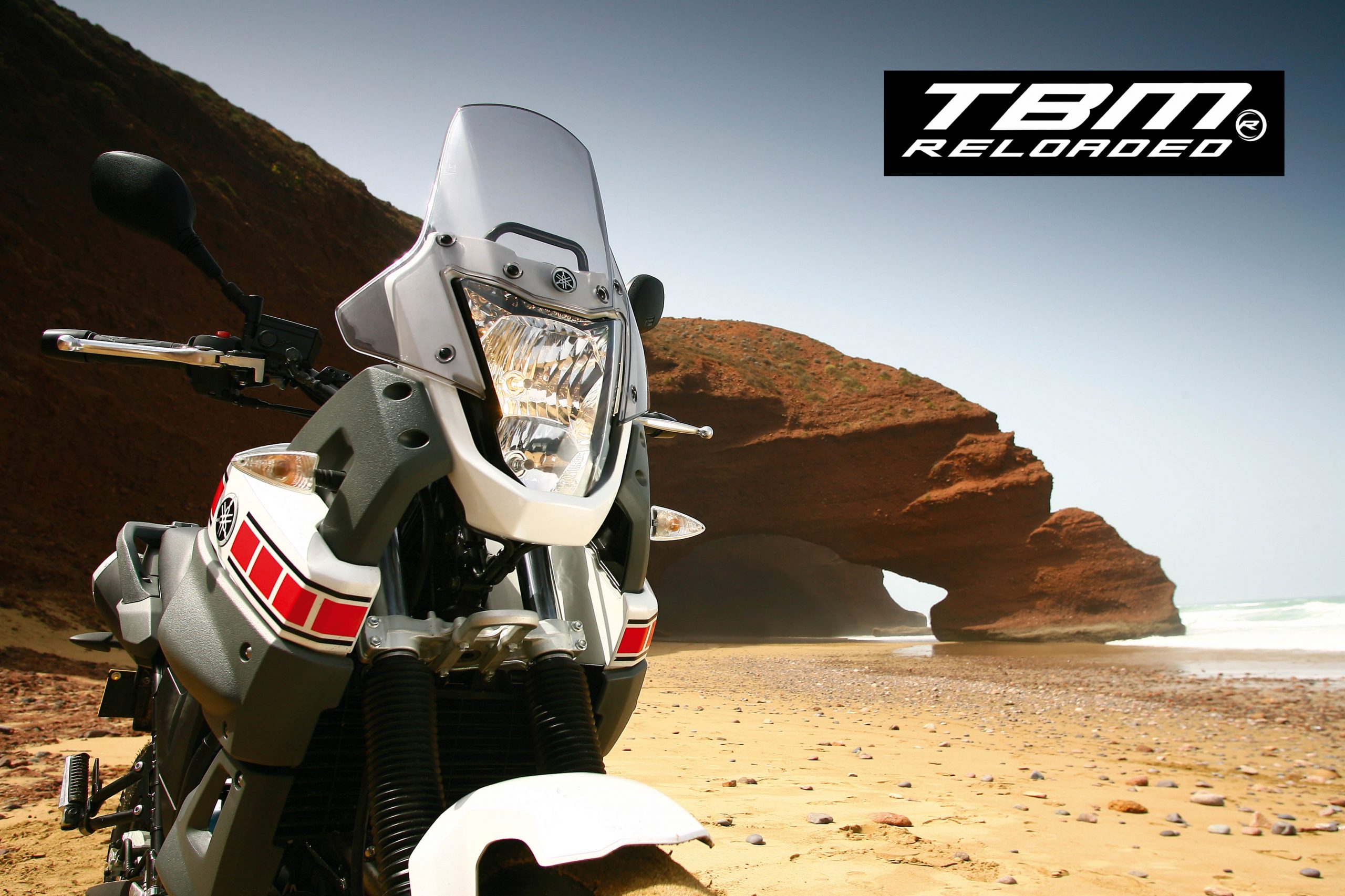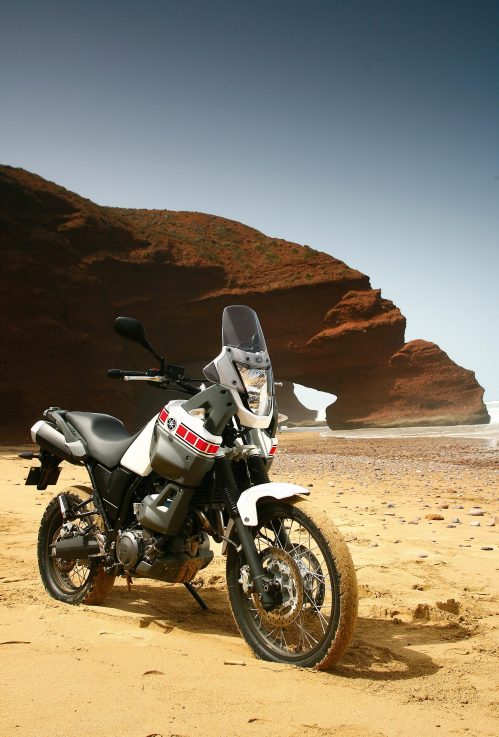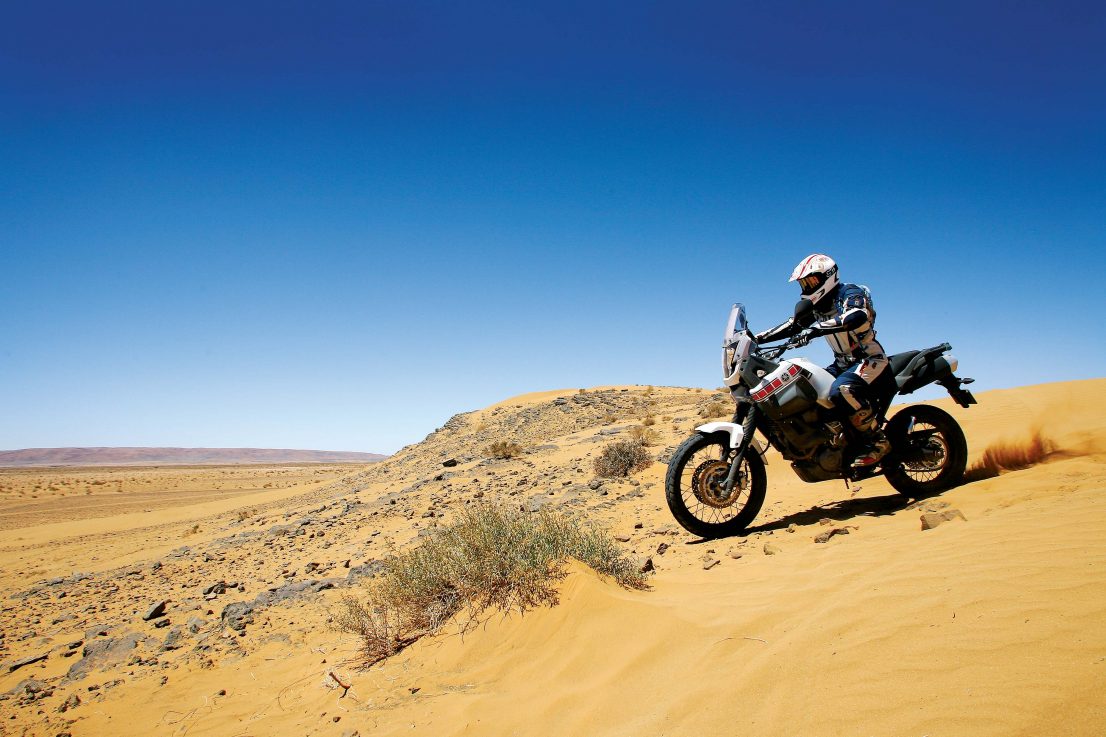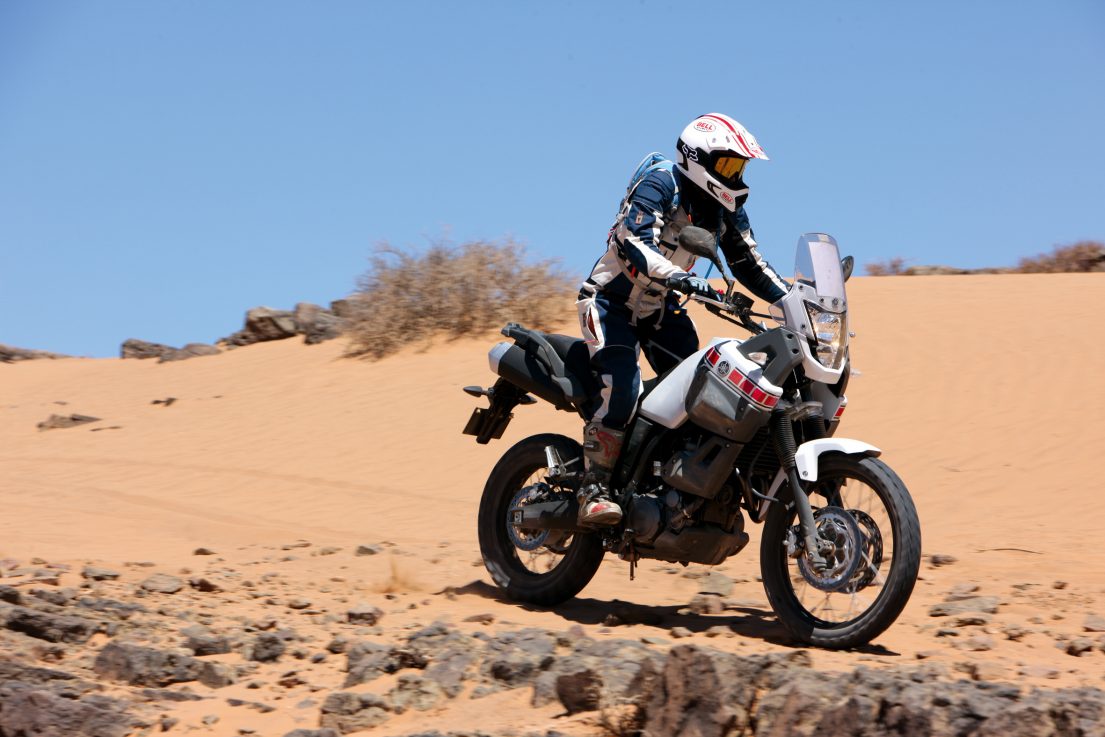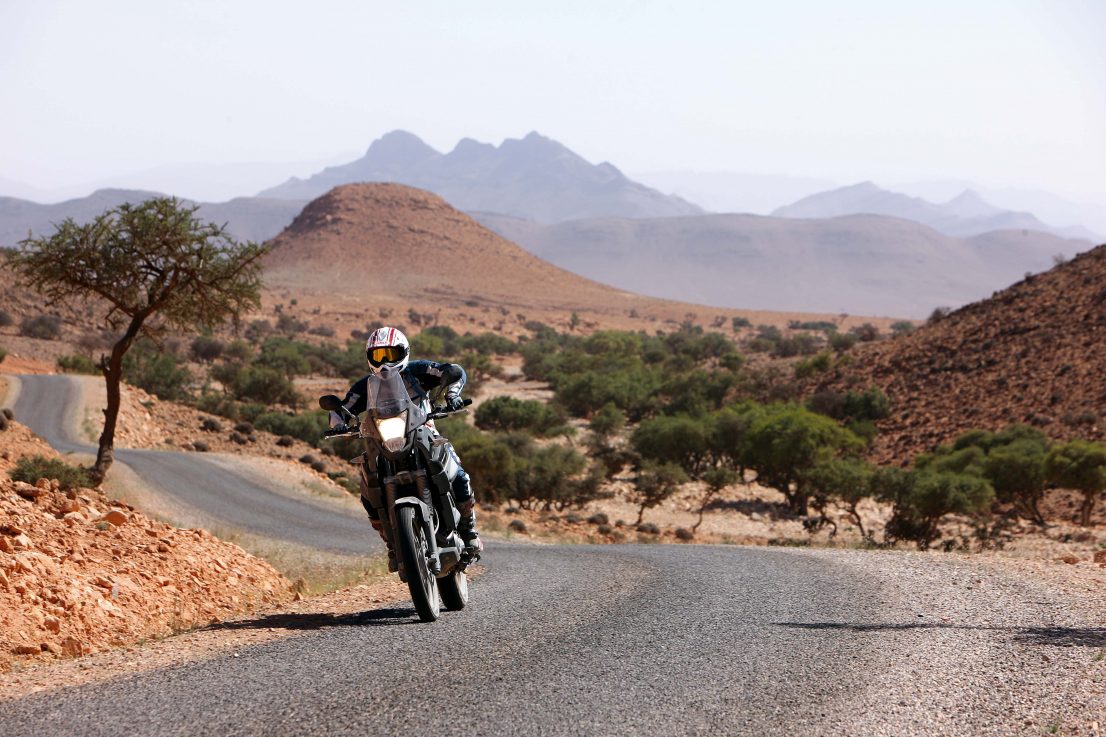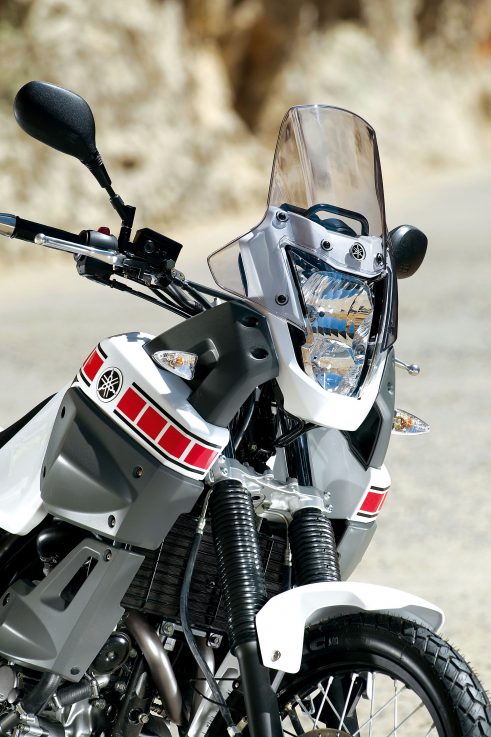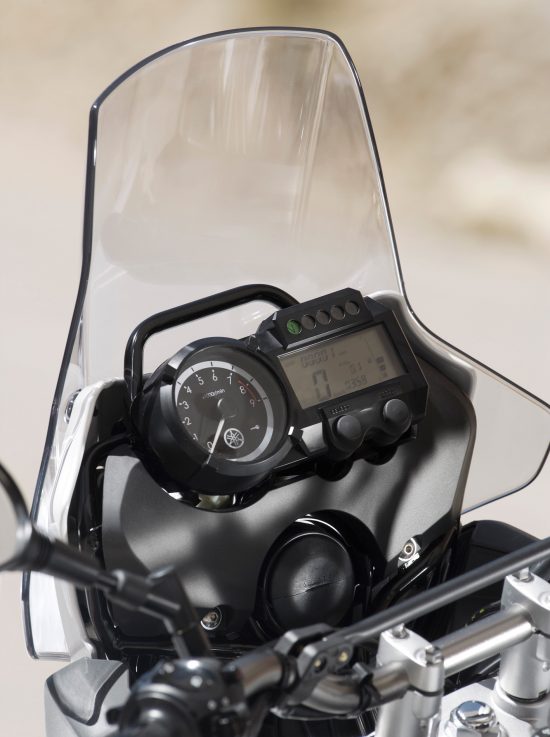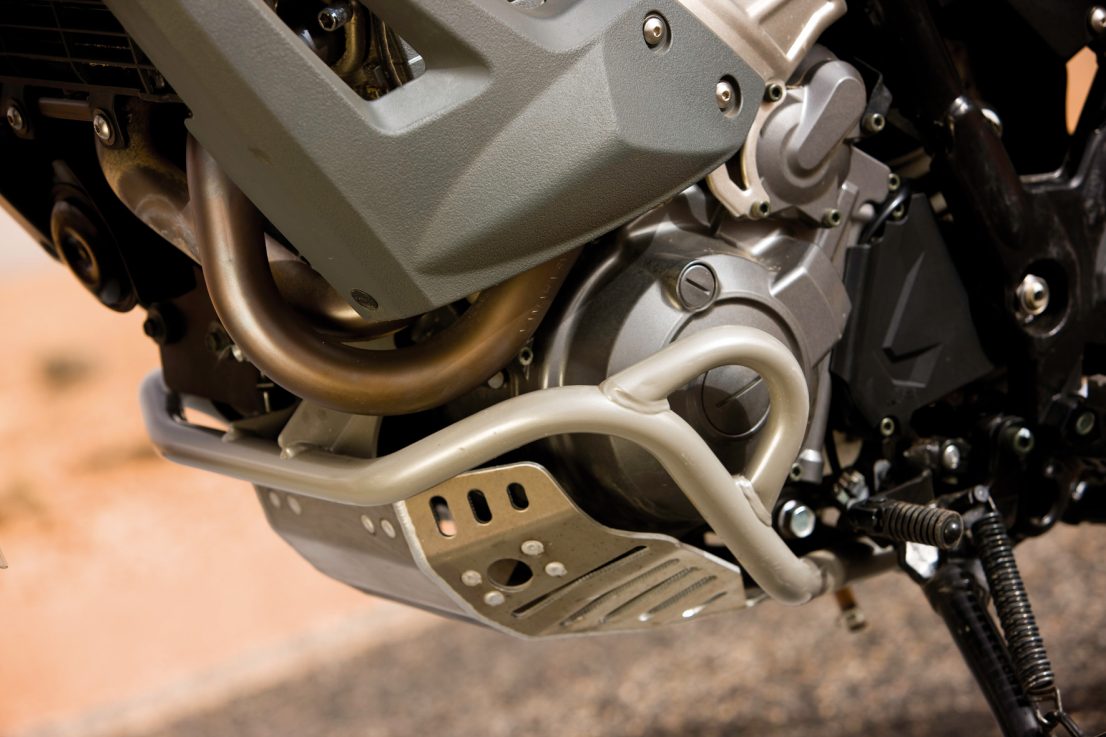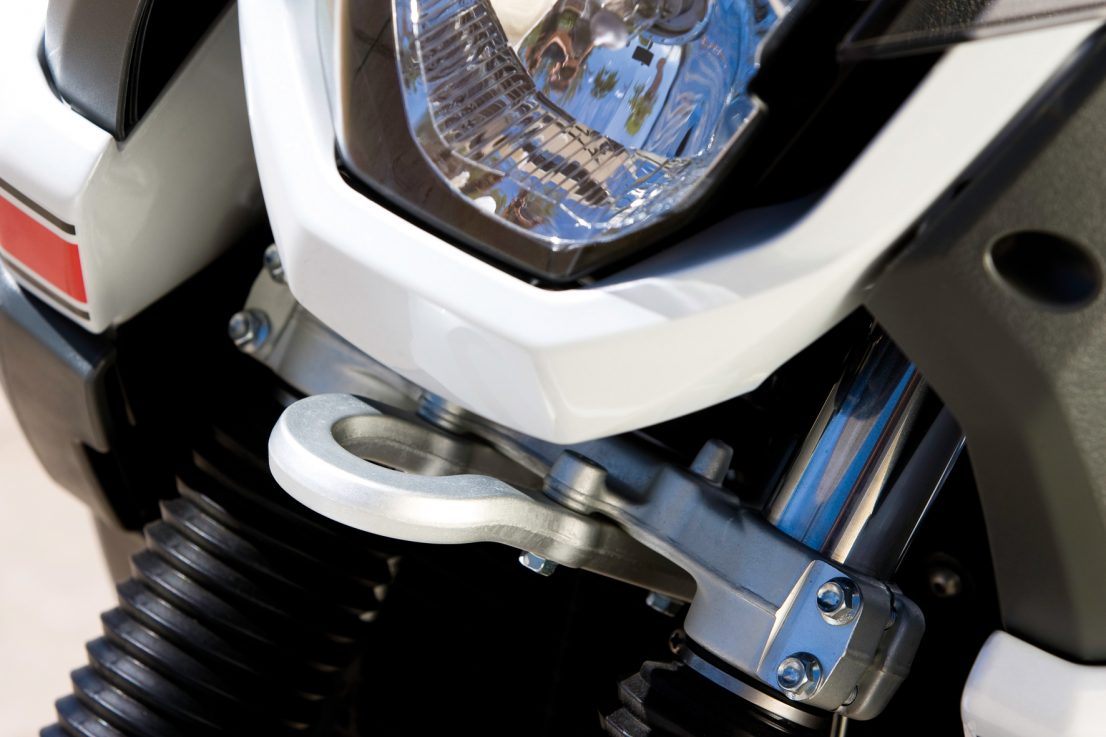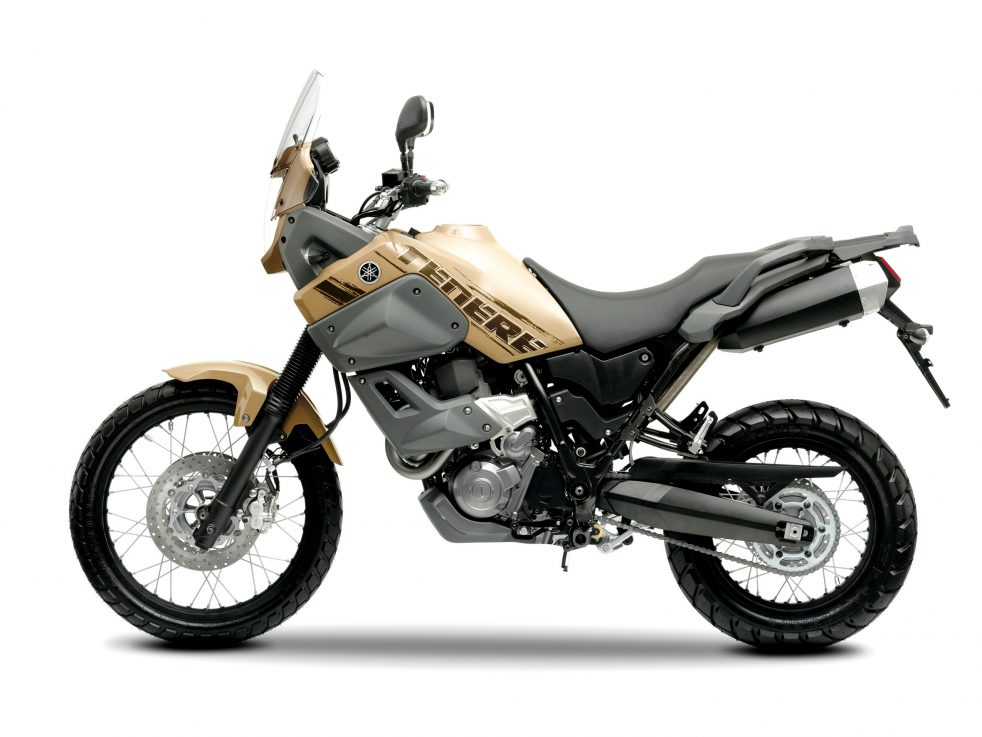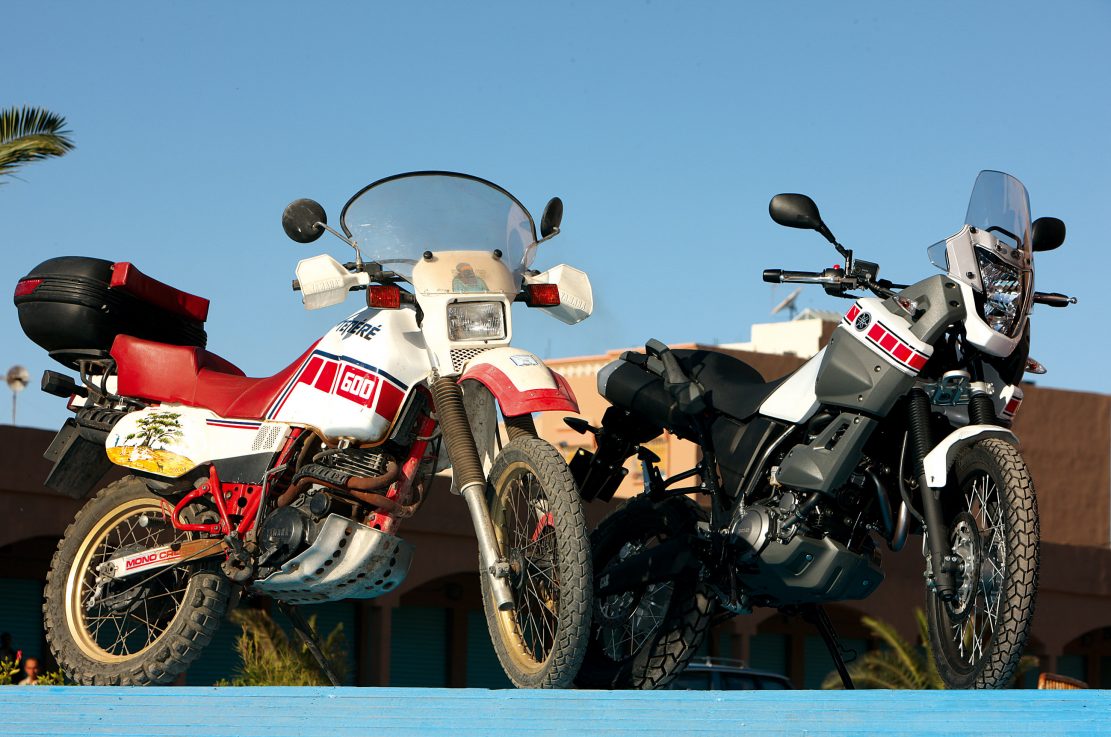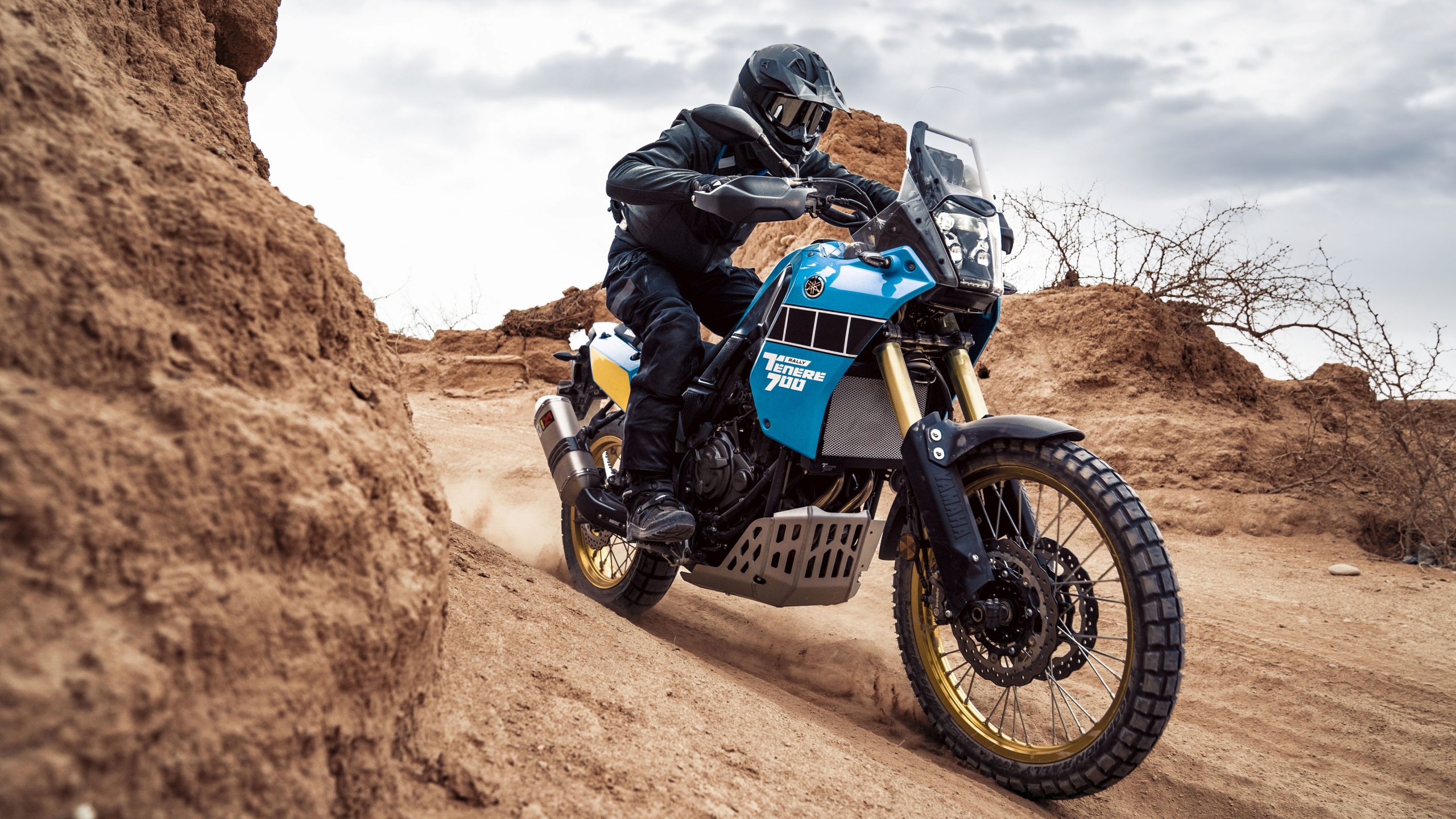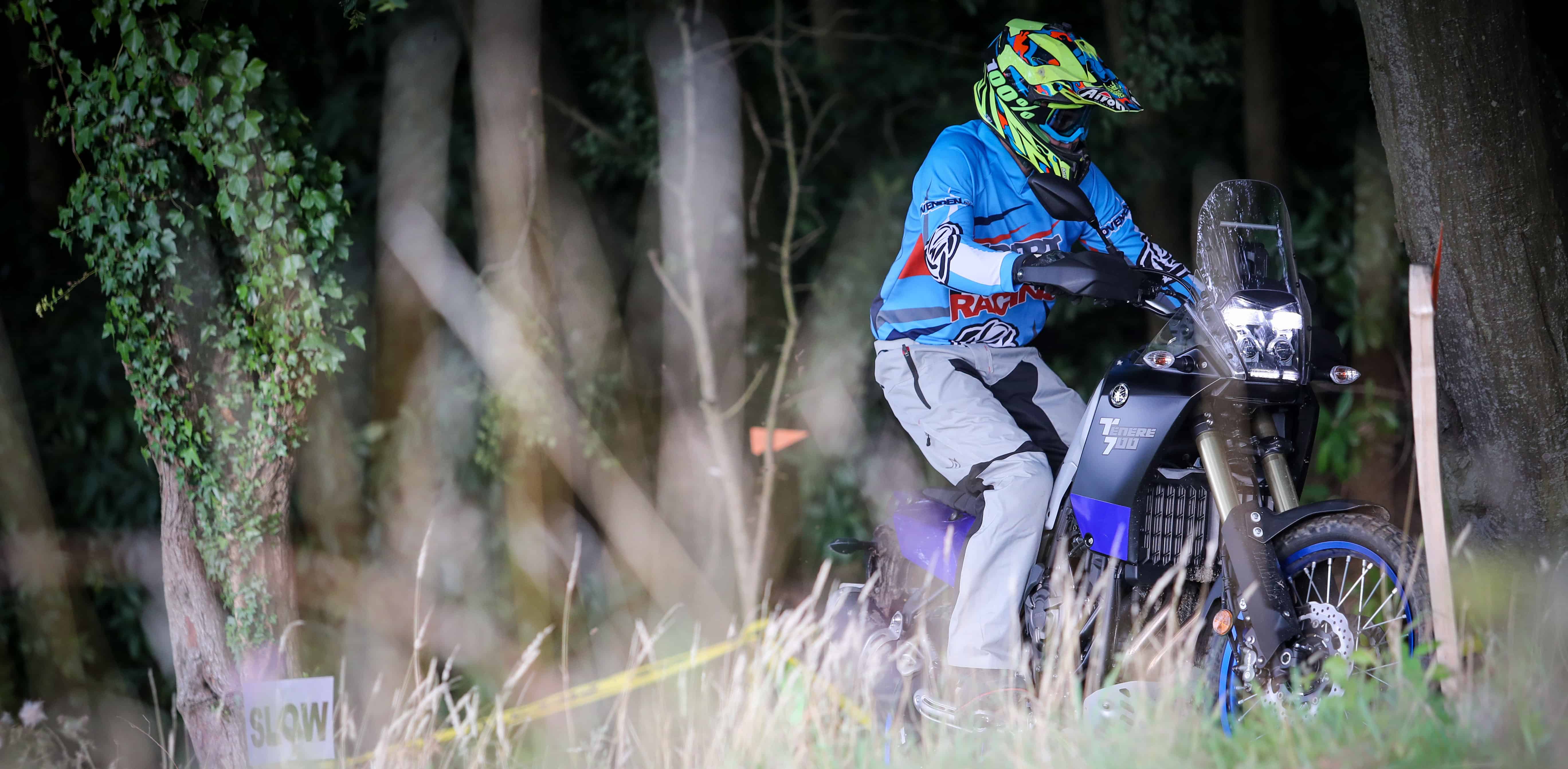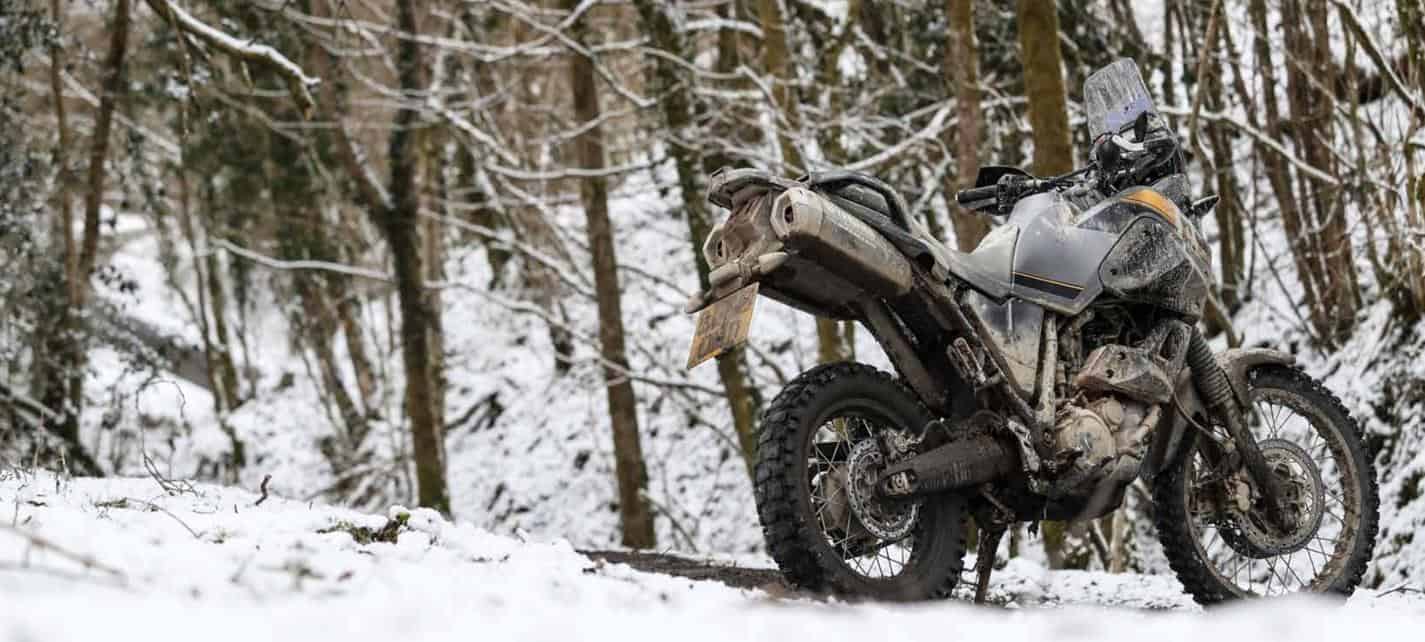words: Mel Falconer images: Yamaha
Fittingly Yamaha chose Morocco for the launch, the same location where the original XT600Z Ténéré was unveiled way back in 1983. With the previous incarnation’s impeccable Dakar-winning pedigree, unburstable reliability and rough ‘n’ tumble looks, the old 600 Ténéré earned an incredibly loyal following back in the 80s and 90s, and was always going to be a tough act to follow.
Thankfully Yamaha seem to understand this. Upon first inspection it’s immediately obvious that a lot of thought has gone into the current Ténéré’s design, both in terms of practicality and layout.
Gone are the prone underslung exhausts that grace the current XT660R. Instead the new bike sensibly routes the vulnerable headers up and over the left-side crankcases, terminating in a neat underseat system which helps improve ground clearance. However, passenger comfort hasn’t been compromised either, thanks to the use of slender ‘temperature reduction mufflers’ which still allow the fitting of hard luggage, while integrated grab-rails provide handy bungy points.
Up front – jutting out from beneath the monster dual headlight assembly – is an integrated steel tow-hook, designed for hauling the bike out of trouble when required (this was to prove very useful at the bike’s launch!) The cockpit is roomy, boasting high quality switchgear, chunky dials and there’s a mount, all ready to accept a GPS. That large fairing is not as vulnerable as it looks thanks to angular grey body protection panels which protrude from the front cowl down to the engine casings. These, I was assured by a very earnest Yamaha Europe representative, are highly effective at preventing major (and expensive) bodywork damage in the case of an impromptu spill. Odd as they initially look, they do add a certain off-road ruggedness to the bike, along with the (optional) metal bashplate and curved engine bars.
The swingarm is a lightweight alloy gravity-cast affair, and the new steel diamond-shaped chassis has an integrated oil reservoir with handy dipstick, very useful if you need to check levels while fully loaded. Another nod to simple, on-the-trail maintenance is the underseat airbox complete with paper filter. The standard toolkit is also located there, and when I removed the seat I noticed that the airbox has four screws to allow reasonably quick access to the filter, yet still maintain a good seal. So far, so good.
Yet more proof that Yamaha have stayed true to their long distance adventure tourer tradition is the bike’s 22L fuel tank – the bulk of which extends beneath the seat, which should help avoid top-heavy handling. Overall the whole package looks simple and tough, two crucial attributes for proper adventure riding.
Oh yes, the looks. With the new Ténéré attracting such tags as Tonka Toy, Transformer, Lego Land and Action Man, I’m not denying that the looks aren’t everybody’s cup of mint tea. But believe me, in the flesh it really works. Especially in the white with red ‘speedblock’ colour scheme. Nobody can accuse it of looking fussy, and for me, it’s got practical off-road looks with a modern twist. Optimus Prime doesn’t stand a chance…
Yamaha have worked hard to build a machine that can match the needs of both the round the world adventurer and (let’s face it), commuter alike. A bike with strong on/off road capabilities, good durability, long distance comfort (for a big single), and the ability to handle anything that’s thrown at it, without losing any of the original’s wanderlustability!
Mel Falconer, TBM , May 2008
Route 66-0
Visual examination over, it was time to see if Yamaha had got the new Ténéré right in terms of the riding experience. As soon as I slung a leg over the wide dual seat, it was reassuring to find I could easily reach the floor both sides in my MX boots (I’m five-feet-six by the way). A definite plus for shorter riders and another tick in the box for Yamaha’s launch hype of the Ténéré being an ‘all-round’ bike for any rider.
Waiting for my chance to set off I checked the planned route, which was approximately 300km, with 40k of that being pure off-road. Fuelled to the brim, as I threaded my way through the town of Tiznit and out onto the winding roads of southern Morocco it was a huge relief to find that the snatchy and stuttering fuel injection glitch that’s plagued the XT660 motor in the past, has now disappeared. A remapped EFI and newly designed 6.8L airbox no doubt play their part. As a result the Ténéré’s throttle-off to throttle-on transition at low revs was a pleasant affair – especially important whilst negotiating some of the smaller side streets in bustling villages where a goat, chicken or small child frequently wanted to get a little too close for comfort.
The gutsy, liquid-cooled lump has lost none of its enormous stomp and has been further tweaked to give maximum grunt at low-to-mid rpm. Shifting up and down the new (and pretty stiff) gearbox, it was sometimes quite hard work to change smoothly in the lower gears and for me at least, neutral was tricky to find, but to be fair the bikes only had a few miles on the clock. On the plus side the standard ratios seemed to complement the XT660Z’s low-end torque output pretty well, and XTs traditionally suffer from clunky ‘boxes, so I’ll reserve judgement until I get another go on a loosened-up machine.
As most of the first couple of hours were spent on a twisty coastal road, fringing the Atlantic Ocean I had plenty of time to get accustomed to the whole touring experience. The long and wide dual seat was soft and generally comfortable and combined with a fairly upright and spacious riding position, you felt like you were sitting in the bike rather than perched on top of it. This feeling was enhanced by the standard tall and slim screen which deflected the wind pretty well. Although taller riders in our group (those people 6ft or more) felt that a taller screen would improve matters.
What I would replace though are the footpegs. With the rubber inserts in for road use they felt too skinny, and didn’t provide much feedback. Once stopped for a mint tea break however, the next section was the 40ks or so of off-road so I took the opportunity of removing the rubber inserts. This was easier said than done, as the standard Yamaha toolkit didn’t have the required allen key size for the job. Doh! But once removed, the pegs were still miles too small to offer decent comfort and control for proper off-road use. With the handlebars now tilted forwards, I was ready to hit the dirt. Well, sand as it turned out. C’mon we were in Morocco after all…
Perfect Ten?
At the press presentation the night before, I’d had a long chat with one of the guys charged with selling the concept of the Ténéré to the assembled hacks, and one of the things he was at pains to point out was that the new bike had been designed first and foremost with off-road performance in mind.
And as soon as we turned off the road and onto loose bumpy tracks I knew the PR pitch had been, for once, spot on. Once standing up, the sculpted fuel tank and narrow frontal design came into its own and afforded a near-perfect riding position, allowing me to effortlessly get my weight forward and because there was less bulk between my legs, I found I could grip easily with my knees too. What surprised me most was how light the bike felt, despite its – and I’m guessing here – nigh-on 210 kilo wet weight. I only weigh about 60kg so if I can fling the thing around, imagine how much easier it’ll be for an average bloke.
Even in fairly deep sandy patches the Ténéré was really manoeuvrable, only made a little flighty at the front end with the road-biased Metzeler Tourance rubber, but as long as your weight was back and you applied the gas it wasn’t a problem – well, most of the time anyway. Because it wasn’t long before the plastic-fantastic protection panels came into their own. Trying to jump up a nasty little sand and rock-strewn gully, I got the bike up – only to drop it on its side at the last moment. True to their word, the fairing bumpers worked a treat and minimal damage was incurred. And as the day wore on with more and more people taking tumbles, the protection panels did their job admirably.
The final part of the off-road route was a fast blast along a twisty rocky track and here the long travel suspension worked well on the whole, soaking up most of the bumps and providing a stable, confident ride, although the gatored forks did crash a bit on some of the faster hits, and I would’ve liked the chance to experiment with the adjustable preload.
Back on a fabulous mountain road heading to the hotel, the Ténéré’s twin front discs with Brembo calipers were a decent improvement over the solitary disc fitted to the front of the XT-R. With good feel and plenty of bite they are powerful enough to haul up the Ténéré easily, yet off-road felt competent without being too sharp or grabby.
Winding the throttle on in top gear along the straights, 660cc powerplant gives as much performance as you’d expect of a (45-50bhp) single cylinder, and while it’s never going to match a twin on this kind of mile-munching, that isn’t really what the Ténéré is all about. And after a day’s hard riding, I certainly didn’t agree with some of the complaints from the other (predominately road-biased) journalists of ‘vibeyness’. The single cylinder thumper’s character is what defines the XT, and is about as proven and reliable a motor as you’re ever going to get. Which in an adventure tourer, is just what you want. And let’s not forget that the original Ténéré was Yamaha’s best selling model in Europe.
Rolling into the garage to fill up, I checked the easy to read digi display and found that I had ridden just under 300km in a day, over mixed terrain and had only just gone into my last fuel ‘bar’ on screen. Pretty damn impressive.
So I suppose the burning question is, does the new bike deserve the famous Ténéré moniker so proudly emblazoned across its flanks? Absolutely, yes. Yamaha have worked hard to build a machine that can match the needs of both the round the world adventurer and (let’s face it), commuter alike. A bike with strong on/off road capabilities, good durability, long distance comfort (for a big single), and the ability to handle anything that’s thrown at it, without losing any of the original’s wanderlustability!
It was a tall order to live up to the classic Ténéré moniker without being regarded as a pastiche of the original, and yet somehow Yamaha have achieved their aims. And for a smidgen over five grand on the road, you’re getting a helluva lot of metal for your moolah.
The biggest downside? Well with limited numbers (approx 150) being brought into the UK for 2008 I’m willing to bet that just like the Mini Clubman, Yamaha’s very own blast from the past is gonna’ be the comeback kid of the year…
Yamaha XT660Z Ténéré
Specification
Price in 2008: £5015 OTR
Engine: SOHC, liquid-cooled, four-valve, fuel injected, electric-start single
Displacement: 660cc
Bore & stroke: 100 x 84mm
Transmission: 5-speed
Frame: Steel-tube, diamond-shaped
Front susp: 43mm telescopic forks (210mm travel), adjustable spring pre-load
Rear susp: Monocross shock with linkage (200mm travel), adjustable spring preload
Front brake: 298mm floating twin disc with Brembo calipers
Rear brake: 245mm single disc
Wheels: Front: 90/90 – 21, Rear: 130/80 – 17
Wheelbase: 1505mm
Seat height: 895mm
Fuel capacity: 22L
Ground clear (min): 245mm
Weight: (dry, claimed) 183kg
Available colours: Competition white, desert khaki, midnight black

